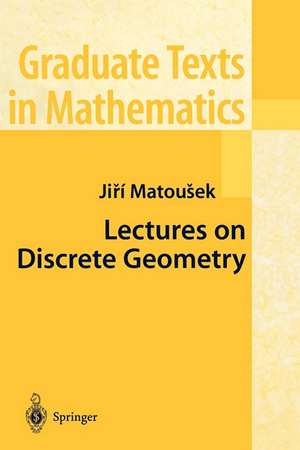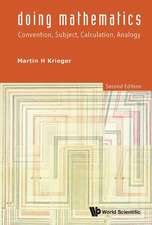Lectures on Discrete Geometry: Graduate Texts in Mathematics, cartea 212
Autor Jiri Matouseken Limba Engleză Paperback – 2 mai 2002
This book is primarily a textbook introduction to various areas of discrete geometry. In each area, it explains several key results and methods, in an accessible and concrete manner. It also contains more advanced material in separate sections and thus it can serve as a collection of surveys in several narrower subfields. The main topics include: basics on convex sets, convex polytopes, and hyperplane arrangements; combinatorial complexity of geometric configurations; intersection patterns and transversals of convex sets; geometric Ramsey-type results; polyhedral combinatorics and high-dimensional convexity; and lastly, embeddings of finite metric spaces into normed spaces.
Jiri Matousek is Professor of Computer Science at Charles University in Prague. His research has contributed to several of the considered areas and to their algorithmic applications. This is his third book.
| Toate formatele și edițiile | Preț | Express |
|---|---|---|
| Paperback (1) | 537.97 lei 6-8 săpt. | |
| Springer – 2 mai 2002 | 537.97 lei 6-8 săpt. | |
| Hardback (1) | 656.89 lei 6-8 săpt. | |
| Springer – 2 mai 2002 | 656.89 lei 6-8 săpt. |
Din seria Graduate Texts in Mathematics
-
 Preț: 402.89 lei
Preț: 402.89 lei - 17%
 Preț: 528.68 lei
Preț: 528.68 lei -
 Preț: 337.46 lei
Preț: 337.46 lei -
 Preț: 383.86 lei
Preț: 383.86 lei - 17%
 Preț: 366.57 lei
Preț: 366.57 lei - 17%
 Preț: 398.97 lei
Preț: 398.97 lei -
 Preț: 355.83 lei
Preț: 355.83 lei -
 Preț: 411.84 lei
Preț: 411.84 lei -
 Preț: 404.48 lei
Preț: 404.48 lei -
 Preț: 289.88 lei
Preț: 289.88 lei - 17%
 Preț: 365.80 lei
Preț: 365.80 lei - 17%
 Preț: 359.45 lei
Preț: 359.45 lei - 15%
 Preț: 488.70 lei
Preț: 488.70 lei - 13%
 Preț: 357.76 lei
Preț: 357.76 lei -
 Preț: 407.88 lei
Preț: 407.88 lei - 13%
 Preț: 352.49 lei
Preț: 352.49 lei - 13%
 Preț: 358.86 lei
Preț: 358.86 lei - 13%
 Preț: 393.48 lei
Preț: 393.48 lei - 11%
 Preț: 351.00 lei
Preț: 351.00 lei - 17%
 Preț: 359.58 lei
Preț: 359.58 lei -
 Preț: 350.46 lei
Preț: 350.46 lei - 8%
 Preț: 567.37 lei
Preț: 567.37 lei -
 Preț: 399.74 lei
Preț: 399.74 lei -
 Preț: 498.91 lei
Preț: 498.91 lei - 20%
 Preț: 571.26 lei
Preț: 571.26 lei - 15%
 Preț: 546.59 lei
Preț: 546.59 lei -
 Preț: 498.69 lei
Preț: 498.69 lei - 15%
 Preț: 354.39 lei
Preț: 354.39 lei -
 Preț: 313.11 lei
Preț: 313.11 lei - 13%
 Preț: 427.40 lei
Preț: 427.40 lei - 17%
 Preț: 363.60 lei
Preț: 363.60 lei -
 Preț: 340.19 lei
Preț: 340.19 lei - 17%
 Preț: 364.47 lei
Preț: 364.47 lei - 17%
 Preț: 366.47 lei
Preț: 366.47 lei - 17%
 Preț: 366.07 lei
Preț: 366.07 lei -
 Preț: 247.59 lei
Preț: 247.59 lei - 17%
 Preț: 367.70 lei
Preț: 367.70 lei - 13%
 Preț: 356.80 lei
Preț: 356.80 lei - 17%
 Preț: 398.78 lei
Preț: 398.78 lei - 17%
 Preț: 398.51 lei
Preț: 398.51 lei - 17%
 Preț: 496.65 lei
Preț: 496.65 lei - 13%
 Preț: 361.80 lei
Preț: 361.80 lei - 15%
 Preț: 482.97 lei
Preț: 482.97 lei -
 Preț: 402.02 lei
Preț: 402.02 lei - 17%
 Preț: 366.57 lei
Preț: 366.57 lei - 20%
 Preț: 449.74 lei
Preț: 449.74 lei -
 Preț: 380.35 lei
Preț: 380.35 lei
Preț: 537.97 lei
Preț vechi: 632.90 lei
-15% Nou
Puncte Express: 807
Preț estimativ în valută:
102.94€ • 110.08$ • 85.83£
102.94€ • 110.08$ • 85.83£
Carte tipărită la comandă
Livrare economică 18 aprilie-02 mai
Preluare comenzi: 021 569.72.76
Specificații
ISBN-13: 9780387953748
ISBN-10: 0387953744
Pagini: 486
Ilustrații: XVI, 486 p.
Dimensiuni: 155 x 235 x 22 mm
Greutate: 0.71 kg
Ediția:Softcover reprint of the original 1st ed. 2002
Editura: Springer
Colecția Springer
Seria Graduate Texts in Mathematics
Locul publicării:New York, NY, United States
ISBN-10: 0387953744
Pagini: 486
Ilustrații: XVI, 486 p.
Dimensiuni: 155 x 235 x 22 mm
Greutate: 0.71 kg
Ediția:Softcover reprint of the original 1st ed. 2002
Editura: Springer
Colecția Springer
Seria Graduate Texts in Mathematics
Locul publicării:New York, NY, United States
Public țintă
GraduateCuprins
1 Convexity.- 1.1 Linear and Affine Subspaces, General Position.- 1.2 Convex Sets, Convex Combinations, Separation.- 1.3 Radon’s Lemma and Helly’s Theorem.- 1.4 Centerpoint and Harn Sandwich.- 2 Lattices and Minkowski’s Theorem.- 2.1 Minkowski’s Theorem.- 2.2 General Lattices.- 2.3 An Application in Number Theory.- 3 Convex Independent Subsets.- 3.1 The Erd?s-Szekeres Theorem.- 3.2 Horton Sets.- 4 Incidence Problems.- 4.1 Formulation.- 4.2 Lower Bounds: Incidences and Unit Distances.- 4.3 Point-Line Incidences via Crossing Numbers.- 4.4 Distinct Distances via Crossing Numbers.- 4.5 Point-Line Incidences via Cuttings.- 4.6 A Weaker Cutting Lemma.- 4.7 The Cutting Lemma: A Tight Bound.- 5 Convex Polytopes.- 5.1 Geometric Duality.- 5.2 H-Polytopes and V-Polytopes.- 5.3 Faces of a Convex Polytope.- 5.4 Many Faces: The Cyclic Polytopes.- 5.5 The Upper Bound Theorem.- 5.6 The Gale Transform.- 5.7 Voronoi Diagrams.- 6 Number of Faces in Arrangements.- 6.1 Arrangements of Hyperplanes.- 6.2 Arrangements of Other Geometric Objects.- 6.3 Number of Vertices of Level at Most k.- 6.4 The Zone Theorem.- 6.5 The Cutting Lemma Revisited.- 7 Lower Envelopes.- 7.1 Segments and Davenport-Schinzel Sequences.- 7.2 Segments: Superlinear Complexity of the Lower Envelope.- 7.3 More on Davenport-Schinzel Sequences.- 7.4 Towards the Tight Upper Bound for Segments.- 7.5 Up to Higher Dimension: Triangles in Space.- 7.6 Curves in the Plane.- 7.7 Algebraic Surface Patches.- 8 Intersection Patterns of Convex Sets.- 8.1 The Fractional Helly Theorem.- 8.2 The Colorful Carathéodory Theorem.- 8.3 Tverberg’s Theorem.- 9 Geometric Selection Theorems.- 9.1 A Point in Many Simplices: The First Selection Lemma.- 9.2 The Second Selection Lemma.- 9.3 Order Types and the Same-Type Lemma.- 9.4 A Hypergraph Regularity Lemma.- 9.5 A Positive-Fraction Selection Lemma.- 10 Transversals and Epsilon Nets.- 10.1 General Preliminaries: Transversals and Matchings.- 10.2 Epsilon Nets and VC-Dimension.- 10.3 Bounding theVC-Dimension and Applications.- 10.4 Weak Epsilon Nets for Convex Sets.- 10.5 The Hadwiger-Debrunner (p, q)-Problem.- 10.6 A (p, q)-Theorem for Hyperplane Transversals.- 11 Attempts to Count k-Sets.- 11.1 Definitions and First Estimates.- 11.2 Sets with Many Halving Edges.- 11.3 The Lovász Lemma and Upper Bounds in All Dimensions.- 11.4 A Better Upper Bound in the Plane.- 12 Two Applications of High-Dimensional Polytopes.- 12.1 The Weak Perfect Graph Conjecture.- 12.2 The Brunn-Minkowski Inequality.- 12.3 Sorting Partially Ordered Sets.- 13 Volumes in High Dimension.- 13.1 Volumes, Paradoxes of High Dimension, and Nets.- 13.2 Hardness of Volume Approximation.- 13.3 Constructing Polytopes of Large Volume.- 13.4 Approximating Convex Bodies by Ellipsoids.- 14 Measure Concentration and Almost Spherical Sections.- 14.1 Measure Concentration on the Sphere.- 14.2 Isoperimetric Inequalities and More on Concentration.- 14.3 Concentration of Lipschitz Functions.- 14.4 Almost Spherical Sections:The First Steps.- 14.5 Many Faces of Symmetric Polytopes.- 14.6 Dvoretzky’s Theorem.- 15 Embedding Finite Metric Spaces into Normed Spaces.- 15.1 Introduction: Approximate Embeddings.- 15.2 The Johnson-Lindenstrauss Flattening Lemma.- 15.3 Lower Bounds By Counting.- 15.4 A Lower Bound for the Hamming Cube.- 15.5 A Tight Lower Bound via Expanders.- 15.6 Upper Bounds for ??-Embeddings.- 15.7 Upper Bounds for Euclidean Embeddings.- What Was It About? An Informal Summary.- Hints to Selected Exercises.
Recenzii
From the reviews:
"Discrete geometry is not quite a newcomer on the stage of mathematics. … The book under review covers … a gap in the pedagogical literature, providing an expository treatment of a wide range of topics in discrete geometry, without assuming too many prerequisites from the reader. … it will be ideal to be used both as a textbook and for self-study. … In fact … this book can be used as a ‘mathematical companion’ to a textbook on computational geometry … ." (Paul A. Blaga, Studia Universitatis Babes-Bolyai Mathematica, Vol. XLVIII (1), March, 2004)
"Matoušek’s excellent new book concerns discrete geometry. … The style is clear and pleasant; things are streamlined and collected in one place, and are explained on simple, concrete examples. … a final chapter on ‘What was it about? An informal summary’ was an innovation that I found to be an excellent idea. Lectures on discrete geometry is a splendid book. I recommend it both to students and researchers in the field, as well as to those who like mathematics for its own inherent beauty." (Imre Bárány, Bulletin of the London Mathematical Society, Issue 35, 2003)
"This book is primarily a textbook introduction to various areas of discrete geometry. In each area, it explains several key results and methods, in an accessible and concrete manner. It also contains more advanced material in separate sections, and thus, it can serve as a collection of surveys in several narrower subfields." (L’ENSEIGNEMENT MATHEMATIQUE, Vol. 48 (3-4), 2002)
"This is an introduction to the field of discrete geometry understood as the investigation of combinatorial properties of configurations of (usually finitely many) geometric objects … . The book is written in a lively and stimulating but very precise style and contains many figures. It gives a good impression of the richness and the relevance of the field." (Johann Linhart, Zentralblatt Math, Vol. 999 (24), 2002)
"Discrete geometry is not quite a newcomer on the stage of mathematics. … The book under review covers … a gap in the pedagogical literature, providing an expository treatment of a wide range of topics in discrete geometry, without assuming too many prerequisites from the reader. … it will be ideal to be used both as a textbook and for self-study. … In fact … this book can be used as a ‘mathematical companion’ to a textbook on computational geometry … ." (Paul A. Blaga, Studia Universitatis Babes-Bolyai Mathematica, Vol. XLVIII (1), March, 2004)
"Matoušek’s excellent new book concerns discrete geometry. … The style is clear and pleasant; things are streamlined and collected in one place, and are explained on simple, concrete examples. … a final chapter on ‘What was it about? An informal summary’ was an innovation that I found to be an excellent idea. Lectures on discrete geometry is a splendid book. I recommend it both to students and researchers in the field, as well as to those who like mathematics for its own inherent beauty." (Imre Bárány, Bulletin of the London Mathematical Society, Issue 35, 2003)
"This book is primarily a textbook introduction to various areas of discrete geometry. In each area, it explains several key results and methods, in an accessible and concrete manner. It also contains more advanced material in separate sections, and thus, it can serve as a collection of surveys in several narrower subfields." (L’ENSEIGNEMENT MATHEMATIQUE, Vol. 48 (3-4), 2002)
"This is an introduction to the field of discrete geometry understood as the investigation of combinatorial properties of configurations of (usually finitely many) geometric objects … . The book is written in a lively and stimulating but very precise style and contains many figures. It gives a good impression of the richness and the relevance of the field." (Johann Linhart, Zentralblatt Math, Vol. 999 (24), 2002)
Textul de pe ultima copertă
Discrete geometry investigates combinatorial properties of configurations of geometric objects. To a working mathematician or computer scientist, it offers sophisticated results and techniques of great diversity and it is a foundation for fields such as computational geometry or combinatorial optimization.
This book is primarily a textbook introduction to various areas of discrete geometry. In each area, it explains several key results and methods, in an accessible and concrete manner. It also contains more advanced material in separate sections and thus it can serve as a collection of surveys in several narrower subfields. The main topics include: basics on convex sets, convex polytopes, and hyperplane arrangements; combinatorial complexity of geometric configurations; intersection patterns and transversals of convex sets; geometric Ramsey-type results; polyhedral combinatorics and high-dimensional convexity; and lastly, embeddings of finite metric spaces into normed spaces.
Jiri Matousek is Professor of Computer Science at Charles University in Prague. His research has contributed to several of the considered areas and to their algorithmic applications. This is his third book.
This book is primarily a textbook introduction to various areas of discrete geometry. In each area, it explains several key results and methods, in an accessible and concrete manner. It also contains more advanced material in separate sections and thus it can serve as a collection of surveys in several narrower subfields. The main topics include: basics on convex sets, convex polytopes, and hyperplane arrangements; combinatorial complexity of geometric configurations; intersection patterns and transversals of convex sets; geometric Ramsey-type results; polyhedral combinatorics and high-dimensional convexity; and lastly, embeddings of finite metric spaces into normed spaces.
Jiri Matousek is Professor of Computer Science at Charles University in Prague. His research has contributed to several of the considered areas and to their algorithmic applications. This is his third book.
Caracteristici
Quickly leads the reader to the edge of current research Introduces many important oncepts and techniques on carefully chosen results where technicalities are used Book does not require any special background beyond undergraduate mathematics























